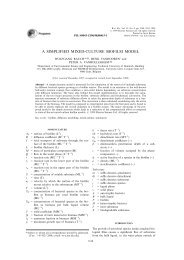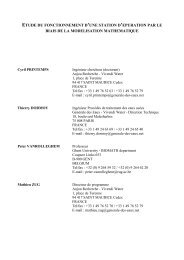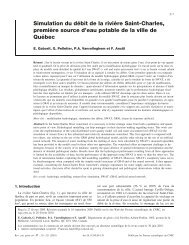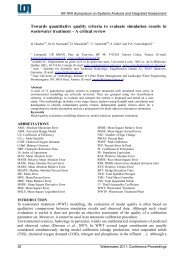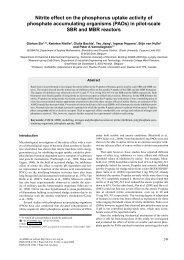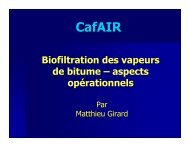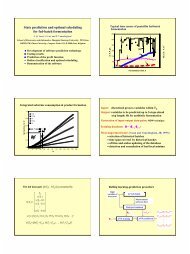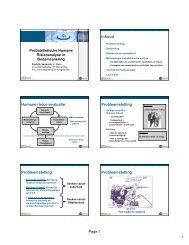Modeling 17α-ethinylestradiol removal in membrane bioreactors
Modeling 17α-ethinylestradiol removal in membrane bioreactors
Modeling 17α-ethinylestradiol removal in membrane bioreactors
You also want an ePaper? Increase the reach of your titles
YUMPU automatically turns print PDFs into web optimized ePapers that Google loves.
Clouzot et al.<br />
<strong>Model<strong>in</strong>g</strong> <strong>17α</strong>-<strong>eth<strong>in</strong>ylestradiol</strong> <strong>removal</strong> <strong>in</strong> <strong>membrane</strong><br />
<strong>bioreactors</strong><br />
Ludiw<strong>in</strong>e Clouzot 1-2 , Frédéric Cloutier 1 and Peter A. Vanrolleghem 1<br />
1 modelEAU, Département de génie civil et de génie des eaux, Université Laval, 1065 avenue de la médec<strong>in</strong>e, G1V<br />
0A6 Québec, Québec, Canada (Emails: ludiw<strong>in</strong>e.clouzot.1@ulaval.ca; frederic.cloutier.1@ulaval.ca;<br />
peter.vanrolleghem@gci.ulaval.ca)<br />
2 Laboratoire de Mécanique, Modélisation et Procédés Propres (M2P2-CNRS-UMR6181), Université Paul Cézanne<br />
d’Aix Marseille, Europôle de l’Arbois, BP 80, Bat. Laennec, Hall C, 13 545 Aix en Provence Cedex 04, France.<br />
Abstract<br />
The aim of this work was to develop a model that describes the fate of the synthetic hormone <strong>17α</strong><strong>eth<strong>in</strong>ylestradiol</strong><br />
(EE2) <strong>in</strong> a <strong>membrane</strong> bioreactor (MBR) process. Results from the modeled<br />
experimental data show that sorption is the ma<strong>in</strong> <strong>removal</strong> mechanism dur<strong>in</strong>g the first 10 days of<br />
exposure to EE2, but the <strong>removal</strong> efficiency drops from 97% to 28% as sorptive capacity saturates.<br />
Then, as the biomass slowly (over a period of 10 days) adapts to the presence of EE2, the <strong>removal</strong><br />
<strong>in</strong>creases aga<strong>in</strong> to 68%. The proposed model considers co-metabolism on soluble EE2 dur<strong>in</strong>g the<br />
aerobic growth of nitrify<strong>in</strong>g bacteria with a logistic function to describe the adaptation period. This<br />
structure is able to represent the observed behaviour of EE2 <strong>in</strong> the studied MBR process.<br />
Keywords<br />
Acclimation; Activated Sludge Model; Co-metabolism; MBR; <strong>Model<strong>in</strong>g</strong>, Emerg<strong>in</strong>g contam<strong>in</strong>ants,<br />
Endocr<strong>in</strong>e disruptors<br />
INTRODUCTION<br />
Conventional activated sludge (CAS) is a widely used bioprocess to treat municipal wastewaters.<br />
With the addition of <strong>membrane</strong> filtration, <strong>membrane</strong> <strong>bioreactors</strong> (MBRs) offer the benefit of<br />
constant effluent quality <strong>in</strong> terms of total suspended solids (TSS) and the high sludge retention time<br />
(SRT) characteristic of MBRs leads to a more diversified and efficient biomass. Activated sludge<br />
models (ASM) are well established for the eng<strong>in</strong>eer<strong>in</strong>g design practice of the wastewater <strong>in</strong>dustry.<br />
While these models were orig<strong>in</strong>ally developed for CAS systems they are now more and more<br />
applied to MBR processes (Fenu et al., 2010). However, key factors still need further <strong>in</strong>vestigation.<br />
Literature <strong>in</strong>dicates that wastewater discharges <strong>in</strong> receiv<strong>in</strong>g waters contribute significantly to the<br />
presence of contam<strong>in</strong>ants of emerg<strong>in</strong>g <strong>in</strong>terest <strong>in</strong> sources of dr<strong>in</strong>k<strong>in</strong>g water (Benotti et al., 2009).<br />
For this purpose, dynamic models of the fate of micropollutants <strong>in</strong> wastewater systems were<br />
developed dur<strong>in</strong>g the SCORE-PP project (Source Control Options for Reduc<strong>in</strong>g Emissions of<br />
Priority Pollutants, www.scorepp.eu). Although the CAS process was <strong>in</strong>cluded <strong>in</strong> the SCORE-PP<br />
project, noth<strong>in</strong>g was proposed for MBR systems. A dedicated literature review revealed various<br />
studies on <strong>removal</strong> of micropollutants <strong>in</strong> MBR (e.g. Sipma et al., 2010, Paetkau et al., 2011) but no<br />
paper has been found on model<strong>in</strong>g their fate. Therefore, the wastewater <strong>in</strong>dustry would benefit from<br />
the development of new models for the <strong>removal</strong> of these particular pollutants <strong>in</strong> MBR. The<br />
objective of the work was thus to develop an MBR model for emerg<strong>in</strong>g contam<strong>in</strong>ants.<br />
The synthetic hormone <strong>17α</strong>-<strong>eth<strong>in</strong>ylestradiol</strong> (EE2), widely used <strong>in</strong> human contraceptives, is an<br />
emerg<strong>in</strong>g contam<strong>in</strong>ant of great concern (Clouzot et al., 2008). EE2 was chosen because it is one of<br />
165
Poster Session<br />
WWTmod2012<br />
the most potent endocr<strong>in</strong>e disrupters and its environmental concentration is known to impact<br />
endocr<strong>in</strong>e system and reproductive functions of aquatic organisms, amphibians, birds and<br />
mammals. EE2 was shown to be primarily removed by sorption <strong>in</strong> CAS system (Andersen et al.,<br />
2005) because this synthetic hormone has a low biodegradability and a high hydrophobicity. EE2<br />
biodegradation has been ma<strong>in</strong>ly attributed to co-metabolism through the key enzyme of<br />
nitrification, the ammonium monooxygenase (AMO) (Yi and Harper, 2007). The long SRT applied<br />
<strong>in</strong> the MBR process supports the development of nitrify<strong>in</strong>g biomass and thus, is expected to<br />
improve EE2 <strong>removal</strong>.<br />
The first step of the study was to collect an extensive experimental data set on EE2 <strong>removal</strong> <strong>in</strong> a<br />
pilot-scale MBR operated under various conditions. Then, the experimental data were used to<br />
develop and calibrate the MBR model. The f<strong>in</strong>al objective was to apply the academic knowledge<br />
acquired for EE2 to the optimization of wastewater treatment plant (WWTP) design and operation.<br />
METHODS<br />
<strong>17α</strong>-<strong>eth<strong>in</strong>ylestradiol</strong><br />
The values of the partition coefficient of EE2, K D , <strong>in</strong> the literature range from 0.28 l/g (Gomes et<br />
al., 2011) to 1.0 l/g (Clara et al., 2004). Its octanol-water partition coefficient, K OW , varies between<br />
4677 l/g and 14125 l/g while its Henry’s law constant is 7.94 * 10 -12 atm.m³/mol (de Mes et al.,<br />
2005). Therefore, EE2 is assumed to be non-volatile and susceptible to sorption. Moreover, studies<br />
have shown that EE2 is slowly biodegradable under aerobic conditions when nitrify<strong>in</strong>g bacteria are<br />
present (Shi et al., 2004).<br />
Experimental data<br />
Activated sludge sampled from a full-scale CAS system was grown on a synthetic substrate (C/N/P:<br />
100/10/2) dur<strong>in</strong>g 83 days <strong>in</strong> a <strong>membrane</strong> bioreactor (MBR) consist<strong>in</strong>g of a reactor followed by an<br />
external <strong>membrane</strong> (Clouzot et al., 2010). Afterwards, EE2 was added <strong>in</strong> the <strong>in</strong>fluent at a constant<br />
concentration of 0.5 mg.L -1 dur<strong>in</strong>g 16 days. The hormone was quantified <strong>in</strong> the permeate to<br />
calculate its <strong>removal</strong>.<br />
The MBR was operated under different conditions to evaluate the effect on EE2 <strong>removal</strong> (Table 1).<br />
A hydraulic retention time (HRT) of 20h was first tested and then, a 7h-HRT was applied to<br />
simulate an overload of pollution. EE2 was removed from the <strong>in</strong>fluent between the two HRTexperiments.<br />
Dissolved oxygen was provided on a cyclic period to allow two hours of aerobic<br />
conditions followed by one hour of anoxic conditions.<br />
Table 1. Operat<strong>in</strong>g conditions of the different experimental phases<br />
Phase 1<br />
(2.4 days)<br />
Phase 2<br />
(4 days)<br />
Phase 3<br />
(8 days)<br />
HRT 20 h 20 h 7 h<br />
EE2 YES NO YES<br />
Substrate YES YES YES<br />
Oxygen YES YES YES<br />
166
Clouzot et al.<br />
<strong>Model<strong>in</strong>g</strong> approach<br />
<strong>Model<strong>in</strong>g</strong> was performed us<strong>in</strong>g the software WEST (www.mikebydhi.com). The pilot plant was<br />
represented by a s<strong>in</strong>gle MBR unit without any backwash<strong>in</strong>g system s<strong>in</strong>ce no <strong>membrane</strong> cleanup<br />
was performed dur<strong>in</strong>g the experiment. Moreover, no foul<strong>in</strong>g was observed dur<strong>in</strong>g the experiment,<br />
and thus, a simple MBR model that does not consider foul<strong>in</strong>g was chosen. A controller and a timer<br />
were used to simulate the cyclic aeration of the reactor and to ma<strong>in</strong>ta<strong>in</strong> the dissolved oxygen<br />
concentration between 0 and 3 mg/l.<br />
The fate of the traditional activated sludge components was described us<strong>in</strong>g the ASM1 model<br />
(Henze et al., 1987) (Table 2). The decay rates of autotrophic biomass (b A ) and heterotrophic<br />
biomass (b H ), the fraction of biomass converted to <strong>in</strong>ert matter (f P ) and the yield for autotrophic<br />
biomass (Y A ) determ<strong>in</strong>ed <strong>in</strong> the MBR experiments of Jiang et al. (2005) were selected. The default<br />
value of the maximum specific growth rates of autotrophic biomass (µ A ) and heterotrophic biomass<br />
(µ H ) at 20°C were chosen s<strong>in</strong>ce they allowed near-complete <strong>removal</strong> of soluble substrate and<br />
ammonia, as was observed dur<strong>in</strong>g the experiment. The yield for heterotrophic biomass (Y H ) was<br />
calibrated <strong>in</strong> order to obta<strong>in</strong> a suspended solids concentration of 13 g/l at steady state, a value that<br />
was rather constant throughout the experiment. The higher value selected for Y H can be expla<strong>in</strong>ed<br />
by the use of glucose as a carbon source, which has a higher yield than acetate and wastewater due<br />
to an enhanced storage metabolism (Dircks et al. 1999).<br />
Table 2. Calibrated values of the ASM1 k<strong>in</strong>etics parameters.<br />
Parameters ASM1 values Calibrated values Units References<br />
(20°C)<br />
b A 0.04 0.08 d -1 Jiang et al. (2005)<br />
b H 0.62 0.25 d -1 Jiang et al. (2005)<br />
f P 0.08 0.06 - Jiang et al. (2005)<br />
µ A 0.8 0.8 d -1 Henze et al. (1987)<br />
µ H 6.0 6.0 d -1 Henze et al. (1987)<br />
Y A 0.24 0.25 g COD /g N Jiang et al. (2005)<br />
Y H 0.67 0.7 g COD /g COD -<br />
RESULTS AND DISCUSSION<br />
The proposed add-<strong>in</strong> to the ASM1 (Henze et al, 1987) <strong>in</strong>cludes two additional components, soluble<br />
concentration of EE2, S EE2 (mg/l) and sorbed concentration of EE2, X EE2 (mg/l), and three<br />
additional processes, sorption/desorption of EE2 on TSS (mg TSS/l) and co-metabolic degradation<br />
of soluble EE2 by nitrify<strong>in</strong>g bacteria, X BA (mg COD/l) (Table 3).<br />
Sorption model<br />
The structure of the sorption/desorption processes mimics the one used by L<strong>in</strong>dblom et al. (2009)<br />
where sorption is described by a pseudo-first order reaction with a sorption rate k sor (l/mg.d), the<br />
TSS concentration and the concentration of soluble EE2. Desorption is proportional to the<br />
concentration of sorbed EE2 <strong>in</strong> a first order manner with a desorption rate k des (d -1 ). At steady-state,<br />
the ratio between the sorption rate and the desorption rate equals K D (l/mg), the partition<br />
coefficient. The data showed that sorption became limited as time went by and this was modeled by<br />
a saturation function similar to the one used <strong>in</strong> the hydrolysis k<strong>in</strong>etic function, but with a<br />
167
Poster Session<br />
WWTmod2012<br />
modification similar to the Hill k<strong>in</strong>etics, i.e. a power-law on the concentration. The parameter K EE2<br />
represents the maximum number of sorption sites that are available for sorption.<br />
Table 3. Gujer matrix of the add-<strong>in</strong> model describ<strong>in</strong>g EE2’s sorption and co-metabolic degradation<br />
Process S O S EE2 X EE2 X BA Process rate (g/m³.d)<br />
Sorption − 1 1<br />
Desorption 1 − 1<br />
Co-metabolic<br />
degradation<br />
by grow<strong>in</strong>g<br />
nitrifiers<br />
168<br />
− 1 1<br />
k<br />
⎛<br />
⎜<br />
EE 2<br />
EE2<br />
∗ X ∗S<br />
∗⎜<br />
⎟<br />
⎜<br />
EE 2<br />
n X<br />
EE 2 ⎛ ⎞ ⎟<br />
sor TSS EE2 n<br />
EE2<br />
⎜ KEE2<br />
+ ⎜ X ⎟<br />
TSS<br />
⎝<br />
k<br />
sor<br />
⋅ X<br />
K<br />
− ( )<br />
NH O EE2<br />
D<br />
EE2<br />
S S S<br />
η t ∗µ ∗ * ∗ ∗X<br />
EE2 A BA<br />
KNH + SNH KOA + SO KNEE2 + SEE2<br />
Biodegradation model<br />
The degradation of EE2 is assumed to be achieved by co-metabolism on soluble EE2 dur<strong>in</strong>g the<br />
aerobic growth of nitrify<strong>in</strong>g bacteria, X BA (mg/l) (Table 3). Hence, a new process rate similar to the<br />
one used for the aerobic growth of autotrophic biomass <strong>in</strong> ASM1 was created for co-metabolic<br />
degradation of EE2. The difference is an additional k<strong>in</strong>etic limitation term, i.e. it stops when no<br />
more EE2 is present. As the results below show, the biodegradation of EE2 is not <strong>in</strong>stantaneous,<br />
some adaptation seems required. To this end a Verhulst-type logistic function (η EE2 ) was added to<br />
the biodegradation k<strong>in</strong>etics (Verhulst, 1845). It is basically a differential equation describ<strong>in</strong>g how<br />
the fraction of the maximum rate that can be obta<strong>in</strong>ed, ƞ EE2 , evolves <strong>in</strong> function of time, t (d):<br />
dη<br />
⎛<br />
EE2<br />
η ⎞<br />
EE2<br />
= kACCηEE2<br />
1−<br />
dt<br />
⎜<br />
⎟ ; which solves <strong>in</strong>to:<br />
⎝ ηEE2,max<br />
⎠<br />
ηEE2,max<br />
* ηEE2,<strong>in</strong>i<br />
η t = ; where:<br />
η + η − η<br />
( )<br />
ACC<br />
( ) e −<br />
EE2 k *t<br />
EE2,<strong>in</strong>i EE2,max EE2,<strong>in</strong>i<br />
η EE2,max , can be viewed as the maximum susta<strong>in</strong>able fraction of the process rate;<br />
η EE2,<strong>in</strong>i , represents an <strong>in</strong>itial fraction of the process rate;<br />
k acc is the rate at which the fraction of the process rate evolves (d -1 ).<br />
Calibration<br />
A partition coefficient was calculated us<strong>in</strong>g the log(K OW ) values found <strong>in</strong> literature and the<br />
empirical formula (Karickhoff, 1981) shown below:<br />
KD = 0.41∗fOC ∗ KOW<br />
,<br />
where f OC is the fraction of organic carbon <strong>in</strong> the biomass. A f OC value of 0.41 was calculated<br />
accord<strong>in</strong>g to the ratio of VSS/TSS of 0.78 that was measured dur<strong>in</strong>g the experiment with a ratio of<br />
K<br />
⎝<br />
n<br />
⎠<br />
⎞<br />
⎟<br />
⎟<br />
⎠
Clouzot et al.<br />
the mass of carbon <strong>in</strong> pure biomass (C 5 H 7 O 2 N) of 0.53. The K D value obta<strong>in</strong>ed was 2.374 l/g,<br />
somewhat higher than what is found <strong>in</strong> literature. Calibration was performed on the sorption rate<br />
(k sor ), a value of 0.5 l/mg.d was applied <strong>in</strong> the model. Parameter values for the co-metabolic<br />
degradation of EE2 were calibrated <strong>in</strong> order to get the best fit dur<strong>in</strong>g phase 3 of the experiment.<br />
Table 4 shows all k<strong>in</strong>etic parameters used <strong>in</strong> the add-<strong>in</strong> model.<br />
Table 4. Calibrated values of the add-<strong>in</strong> model’s k<strong>in</strong>etic parameters.<br />
Parameters Calibrated values Units<br />
k sor 0.5 l/mg.d<br />
k des 210 d -1<br />
K EE2 0.00022 -<br />
n EE2 2 -<br />
k ACC 0.95 d -1<br />
η EE2,<strong>in</strong>i 9*10 -6 -<br />
η EE2,max 0.25 -<br />
K NEE2 0.6 mg/l<br />
The percentage of EE2 <strong>removal</strong> was measured dur<strong>in</strong>g the last 14 days of the MBR experiment<br />
(Figure 1). When EE2 was first added at a 20h-HRT, the <strong>removal</strong> gradually decreased from 100%<br />
to 90% over a period of three days. Sorption was characterized as the ma<strong>in</strong> <strong>removal</strong> mechanism<br />
(Clouzot et., 2010) and the model successfully described the experimental data for this phase.<br />
Figure 1. Experimental and modeled <strong>removal</strong> efficiencies of EE2 <strong>in</strong> the pilot-scale MBR.<br />
A simulation performed without the co-metabolism k<strong>in</strong>etic shows that long-term <strong>removal</strong> of EE2 by<br />
sorption stabilizes at 5%. This rather low value can be expla<strong>in</strong>ed by the long SRT applied to the<br />
model, which reta<strong>in</strong>s most of the sorbed EE2 and therefore saturates the sorption sites available <strong>in</strong><br />
the Hill k<strong>in</strong>etics, and by the high <strong>in</strong>fluent load of EE2 applied to the MBR.<br />
169
Poster Session<br />
WWTmod2012<br />
The same trend was observed at the beg<strong>in</strong>n<strong>in</strong>g of the 7h-HRT phase. The <strong>removal</strong> decreased from<br />
97% to 28% due to the saturation of the sorption sites and then, biodegradation <strong>in</strong>creased the<br />
<strong>removal</strong> efficiency to 68%. Results from this experiment showed that biomass required an<br />
adaptation phase of about 10 days before it could biodegrade EE2. The proposed model is rather<br />
good at describ<strong>in</strong>g the beg<strong>in</strong>n<strong>in</strong>g of phase 3, where only sorption is a factor <strong>in</strong> the <strong>removal</strong> of EE2.<br />
Then, the model results show that the Verhulst adaptation k<strong>in</strong>etics was quite successful <strong>in</strong><br />
<strong>in</strong>tegrat<strong>in</strong>g EE2 co-metabolism <strong>in</strong> the model.<br />
Model application<br />
Several simulations were performed <strong>in</strong> order to evaluate the <strong>removal</strong> efficiency of EE2 <strong>in</strong> different<br />
operat<strong>in</strong>g conditions. The <strong>removal</strong> efficiencies reported <strong>in</strong> Table 5 were obta<strong>in</strong>ed after a steadystate<br />
was achieved for HRT values of 20h and 7h. The results show that the MBR rema<strong>in</strong>s efficient<br />
at remov<strong>in</strong>g EE2 when the HRT is 20h, even at low temperature (Exp. 2), with a lower<br />
aerobic/anoxic ratio (Exp. 3), and at an SRT of 5 days (Exp. 4). However, when the SRT is lowered<br />
to 2 days (Exp. 5), the complete absence of nitrification has a significant effect on the <strong>removal</strong> of<br />
EE2. Moreover, <strong>in</strong> that specific scenario, the TSS concentration <strong>in</strong> the wasted sludge is less than 1.5<br />
g/l, therefore, nearly 30% of the <strong>in</strong>fluent EE2 is discharged with the sludge as soluble EE2. When<br />
the HRT was set to 7h, the operat<strong>in</strong>g conditions had a greater impact on the <strong>removal</strong> efficiencies.<br />
The lower temperature altered nitrification, but it <strong>in</strong>creased the TSS concentration <strong>in</strong> the reactor,<br />
which allowed more sorption to occur. At a SRT of 2 days, no nitrification and co-metabolism was<br />
observed, which means that EE2 was only removed by sorption.<br />
Table 5. Removal percentages at steady-state under various operat<strong>in</strong>g conditions.<br />
Exp. 1 Exp. 2 Exp. 3 Exp. 4 Exp. 5<br />
SRT (d) 50 50 50 5 2<br />
Temperature (°C) 20 5 20 20 20<br />
Aeration 2h/1h (no) 2h/1h (no) 1h/2h (no) 2h/1h (no) 2h/1h (no)<br />
Removal % @ HRT 7h 71 65 71 60 26<br />
Removal % @ HRT 20h 90 88 89 86 61<br />
CONCLUSION<br />
In this paper, an add-<strong>in</strong> model to ASM1 that describes the fate of the synthetic hormone <strong>17α</strong><strong>eth<strong>in</strong>ylestradiol</strong><br />
<strong>in</strong> a MBR pilot was presented. The proposed model was able to adequately<br />
represent the different <strong>removal</strong> phases, such as the dynamically faster sorption process <strong>in</strong> the first<br />
10 days and the co-metabolic mechanism that required an adaptation period modeled with a<br />
Verhulst k<strong>in</strong>etic. Various scenarios were analyzed and showed that the low SRT values had a<br />
significant impact on the <strong>removal</strong> of EE2 because it alters both nitrification and co-metabolism.<br />
ACKNOWLEDGEMENT<br />
The authors would like to thank Benoît Marrot and Nicolas Roche from M2P2 <strong>in</strong> Marseille, France<br />
for the experimental data collected. They also thank the Canada Research Chair <strong>in</strong> Water Quality<br />
<strong>Model<strong>in</strong>g</strong> and the Canadian Water Network project EC-2 for f<strong>in</strong>ancial support.<br />
170
Clouzot et al.<br />
REFERENCES<br />
Andersen H.R., Hansen M., Kjlholt J., Stuer-Lauridsen F., Ternes T. and Hall<strong>in</strong>g-Srensen B. (2005). Assessment of the<br />
importance of sorption for steroid estrogens <strong>removal</strong> dur<strong>in</strong>g activated sludge treatment. Chemosphere, 61, 139–<br />
146.<br />
Benotti M.J., Trenholm R.A., Vanderford B.J., Holady J.C., Stanford B.D. and Snyder S.A. (2009). Pharmaceuticals<br />
and endocr<strong>in</strong>e disrupt<strong>in</strong>g compounds <strong>in</strong> U.S. dr<strong>in</strong>k<strong>in</strong>g water. Environ. Sci. Technol., 43(3), 597-603.<br />
Clara M., Strenn B., Saracevic E. and Kreuz<strong>in</strong>ger N. (2004). Adsorption of bisphenol-A, 17β-estradiole and <strong>17α</strong><strong>eth<strong>in</strong>ylestradiol</strong>e<br />
to sewage sludge. Chemosphere, 56, 843–851.<br />
Clouzot L., Doumenq P., Roche N. and Marrot B. (2010). Membrane <strong>bioreactors</strong> for <strong>17α</strong>-<strong>eth<strong>in</strong>ylestradiol</strong> <strong>removal</strong>. J.<br />
Membr. Sci., 362(1-2), 81-85.<br />
Clouzot L., Marrot B., Doumenq P. and Roche N. (2008). <strong>17α</strong>-<strong>eth<strong>in</strong>ylestradiol</strong>: An endocr<strong>in</strong>e disrupter of great<br />
concern. Analytical methods and <strong>removal</strong> processes applied to water purification. A review. Environ. Prog.<br />
(AIChE), 27(3), 383-396.<br />
de Mes T., Zeeman G. and Lett<strong>in</strong>ga G. (2005). Occurence and fate of estrone, E2 and EE2 <strong>in</strong> STPs for domestic<br />
wastewater. Rev Environ Sci Biotechnol, 4, 275–311<br />
Dircks K., P<strong>in</strong>d P.F., Mosbæk H. and Henze M. (1999). Yield determ<strong>in</strong>ation by respirometry - The possible <strong>in</strong>fluence of<br />
storage under aerobic conditions <strong>in</strong> activated sludge. Water SA, 25, 69-74.<br />
Fenu A., Guglielmi G., Jimenez J., Spérandio M., Saroj D., Lesjean B., Brepols C., Thoeye C. and Nopens I. (2010).<br />
Activated sludge model (ASM) based modell<strong>in</strong>g of <strong>membrane</strong> bioreactor (MBR) processes: A critical review<br />
with special regard to MBR specificities. Water Res., 44, 4272-4294.<br />
Gomes R.L., Scrimshaw M.D., Cartmell E. and Lester J.N. (2011). The fate of steroid estrogens: partition<strong>in</strong>g dur<strong>in</strong>g<br />
wastewater treatment and onto river sediments. Enviro Monit Assess, 175, 431-441.<br />
Henze M., Grady C.P.L. Jr., Gujer W., Marais G.v.R. and Matsuo T. (1987). Activated Sludge Model No. 1. IAWQ<br />
Scientific and Technical Report No. 1, London, UK.<br />
Karickhoff S.W. (1981). Semi-empirical estimation of sorption of hydrophobic pollutants on natural sediments and<br />
soils. Chemosphere, 10, 833-846.<br />
L<strong>in</strong>dblom E., Press-Kristensen K., Vanrolleghem P.A., Mikkelsen P.S. and Henze M. (2009). Dynamic experiments<br />
with high bisphenol-A concentrations modelled with an ASM model extended to <strong>in</strong>clude a separate XOC<br />
degrad<strong>in</strong>g microorganism. Water Res., 43, 3169-3176.<br />
Paetkau M., Yang W. and Cicek N. (2011). Eth<strong>in</strong>ylestradiol <strong>removal</strong> <strong>in</strong> a conventional and a simultaneous nitrificationdenitrification<br />
membreane bioreactor. Wat. Sci. Technol., 64, 2333-2337.<br />
Shi J., Fujisawa S., Nakai S. and Hosomi M. (2004). Biodegradation of natural and synthetic estrogens by nitrify<strong>in</strong>g<br />
activated sludge and ammonia-oxidiz<strong>in</strong>g bacterium Nitrosomonas europaea. Water Res, 38, 2323-2330.<br />
Sipma J., Osuna B., Collado N., Moclùs H., Ferrero G., Comas J. and Rodriguez-Roda I. (2010). Comparison of<br />
<strong>removal</strong> of pharmaceuticals <strong>in</strong> MBR and activated sludge systems. Desal<strong>in</strong>ation, 250(2), 653-659.<br />
Verhulst P-F. (1845). Recherches mathématiques sur la loi d'accroissement de la population. Mem. Acad. Sci. Lett.<br />
Belg., 18, 1-38.<br />
Yi T. and Harper W.F. (2007). The l<strong>in</strong>k between nitrification and biotransformation of <strong>17α</strong>-<strong>eth<strong>in</strong>ylestradiol</strong>. Environ.<br />
Sci. Technol., 41, 4311–4316.<br />
171



